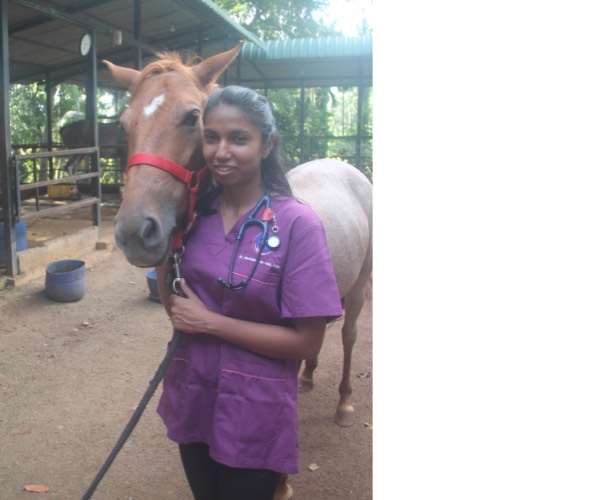
Oct 04 2022.
views 504Dr. Alexandria de Lima enjoys working with horses and larger animals. Having had her primary education at Royal Institute International School, Nugegoda, her love for animals was her inspiration to further her studies in veterinary medicine. Dr. de Lima graduated as a Doctor of Veterinary Medicine (Malaysia) and is currently pursuing a Master in Veterinary Science at Universiti Putra, Malaysia. While single-handedly operating her private clinic, Dr. de Lima also provides her services to the Ceylon Riding Club. Speaking to the Women at Work, Dr. de Lima spoke about her journey as an equine veterinarian, her experience with horses, the lack of education about horses in Sri Lanka and the challenges faced.
Excerpts :

Q What inspired you to become an equine veterinarian?
When I was around eight years old we went to the Yala National Park on a safari and after listening to what I was talking about the animals from what I have read about them, the tracker suggested that I should do veterinary medicine. Since then this idea was implanted in me and that’s how I chose to study veterinary medicine. I chose to do equine medicine, after working in the university horse stables, where I learned what incredible animals horses were. I had to learn how to care for them and through that, I learned that they had unique and interesting personalities.
Q How did you specialize in this field?
So after A/Ls, when I was looking for higher studies options, different countries have different requirements. With the A/L results, I was able to sit for the Doctor of Veterinary Medicine course at Universiti Putra in Malaysia which is a Master's level course. Therefore I didn’t have to do an undergraduate degree. In Malaysia, our London A/Ls are similar to their foundation-level courses.
Q Why did you choose horses over other animals?
I initially wanted to specialize in wildlife but large animal medicine is stereotyped as a males-only field. But I didn’t know how to enter the Wildlife Department without knowing the government protocols. You have to be a government veterinarian to join the DWC. During university, we have to do what you call Industrial Training which includes different fields such as cattle medicine, swine, small animals such as goats and so on. In my third year, I decided to do dairy cattle medicine and I was stationed at NLDB somewhere close to Bopaththalawa and was there for about six weeks. Fortunately, at the time a lecturer was also interested in dairy cattle medicine, and I did my undergraduate thesis under him. Because I was in the ruminant section and our hospital was designed in such a way that the large animals were in one unit, we had horses and ruminants in one hospital. Then we have to check on the horses as well. I knew that there were no horse vets here and I wanted to do my main job on dairy cattle medicine and work with horses on a part-time basis. But vets are undervalued for their job and after I graduated and returned I realized that the pay wasn’t sufficient enough at dairy farms. Then I joined the Pet Vet clinic because even though they primarily attend to small animals they said that I could work on the horses. It was a great opportunity because they were already established and they got down any special equipment that I required to practice horse medicine.
Q Why do you say that vets are undervalued?
In other countries, there are student loan debts because the industry doesn’t make enough money for students to cover up their loans. When compared to medical doctors we are paid around one-fourth of what they earn. Financially it can be difficult for us. Then there are mental health issues as well because veterinarians have what is called compassion fatigue because we care so much about what we do. We don’t become vets unless we have a passion for it. You also develop a connection with patients who are animals. It gets very emotional and you do so much that you burn yourself out. We are underappreciated for what we are doing and overworked. I have never left work on time. People also think that vets are expensive and that if you love animals the service should be free. I can provide a free service but how can I keep the lights on at home?
Q Let’s talk about your clinic and the services offered...
It was Dr Nalinika Obeysekara the then Director at Pet Vet Clinic who introduced me to Ineke and that’s how I started practising horse medicine for the Ceylon Riding Club. Now I run my own private practice called Horse Care, Equine Veterinary Services. While I was still with Pet Vet and at end of 2020, I joined another Masters of Veterinary Science (Equine Medicine) programme in Malaysia. Back then I was able to do one semester online due to the pandemic and in 2021 I went there to do my research and I’m in the process of writing the thesis. My supervisor (Dr Nurul Hayah Khairuddin) was the Head of the Department of Farm and Exotic Animal Medicine and Surgery who was extremely supportive of my interest to learn more about equine medicine and mentored me throughout my time in the Large Animal Ward of the University Veterinary Hospital, Malaysia.
I would call Horse Care, Equine Veterinary Services an ambulatory service. I go out and do visits, and care depends on what the horses need at the time. We provide preventative health services because we’d rather prevent a problem than treat a problem. Our services include vaccinations, deworming and other preventative services and in certain instances, we attend to emergencies such as colics and injuries.
Q We have heard about elite families having domesticated horses. Is it a trend now in Sri Lanka?
This is quite a secretive community. Surprisingly there are a lot of horses in the country and there’s no documentation on the registration of animals. This is a welfare issue as well because people are buying horses but they don’t know how to properly take care of them. The ponies are mixed with the thoroughbreds. Then there’s a mix of breeds in Sri Lanka which are not found anywhere else in the world such as half-breeds, quarter-breeds and three-quarter breeds. They should be educated about their breeding because of possible complications during pregnancy or while giving birth; fouls are born without an immune system so if they don’t get their colostrum within the first four hours, within 12 hours things would turn fatal.
Q What are the common diseases among horses?
The main problem with horses in Sri Lanka is that we don’t have the proper required grass or horse feed and as a result they get colic. The cause of the abdominal pain could be different reasons, the horse may either be bloated up, or there could be feed stuck in a particular corner preventing everything from going through. The problem with horses is that they can’t vomit. The sphincters at the oesophagus and the gastric area are so tight that feed can only go one way and not the other. Since they cannot vomit, everything collects inside. The main treatment here is where you pass a nasogastric tube and it’s a very challenging thing to do. For me, early intervention saves lives. If it’s within 24 hours then you have a better prognosis. Horses require around 20-30 litres of saline for a day when they have colic. But we can only give around 2.5 litres as we don’t have the proper requirement.
Q What is the most satisfying part about the work you do?
Apart from getting to pet all the animals, solving difficult cases, trying to figure out the root cause of the problem, and doing treatments and surgeries. I used to do emergency surgeries while at Pet Vet and my favourite is conducting C-sections because babies come out! It’s very stressful because you have two teams working with you; one team focuses on the mother and the other on the baby. Some dogs have natural births but they also have complications like not having the strength to push etc. If the baby hasn’t come out for six hours then we quickly take the dog for surgery. The first experience in my equine practice that made me very happy was when I successfully placed a nasogastric tube.
Q What is the most challenging part about being a vet?
When it comes to equine medicine many pharmaceutical suppliers don’t bring the proper drugs down. The doses we have are very low because they are essentially for humans. It’s the same with antibiotics. Equipment is expensive because you need a complete set. You need rasps and other specific equipment and the prices are unmatchable for us. Equipment from other countries come with a five-year warranty. If there’s an issue you can get a new one completely or send it for repairs. The other challenge is getting people to trust vets again, especially the horse owners. Their past experiences with vets are bad so they have a general perception about all vets. People call us very late to attend to a horse. By the time we go there, the case has become fatal. It should be the owner’s responsibility to call us as early as possible.
It is alright for owners to give medication under the supervision of a vet.

Q Future aspirations
If you want to specialize in a certain field there are board certification examinations called residencies. So I want to apply for one of them. The problem with other countries is that there is a licensing issue. So without a license, you cannot practice. I have licenses in Sri Lanka and Malaysia and if I want to do it in Australia I have to do the entire examination again. But in USA and Canada, I can do it under the University lecturers’ licenses. In terms of my clinic, the next step would be to bring down diagnostic equipment such as radiographs and ultrasounds. If it’s going well I would want to build a hospital at one point.
Q Your message to people who already have horses or those who are planning to buy one?
If you have a horse or if you are going to get a horse, education is very important. Even if you think you know, there’s so much you need to know. Even in my field, I can’t say that I know everything. There are better experts than me and even for them, they have to learn new things every day. It’s a very difficult thing for people to admit that they don’t know. It’s alright to ask for help and there are many people who will come for help.
In my parting comments I want to thank Dr Siraya Chunekamrai who is currently the President of the World Small Animal Veterinary Association because if it wasn’t for her, I wouldn’t have come this far.
0 Comments